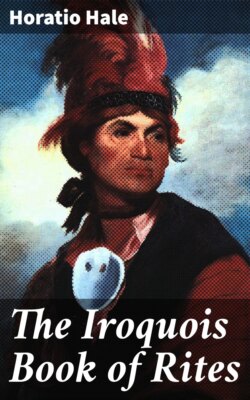The Iroquois Book of Rites

Реклама. ООО «ЛитРес», ИНН: 7719571260.
Оглавление
Horatio Hale. The Iroquois Book of Rites
The Iroquois Book of Rites
Table of Contents
PREFACE
MAP. INTRODUCTION. CHAPTER I. THE HURON-IROQUOIS NATIONS. CHAPTER II. THE LEAGUE AND ITS FOUNDERS. CHAPTER III. THE BOOK OF RITES. CHAPTER IV. THE CONDOLING COUNCIL.—CLANS AND CLASSES. CHAPTER V. THE CONDOLENCE AND THE INSTALLATION. CHAPTER VI. THE LAWS OF THE LEAGUE. CHAPTER VII. HISTORICAL TRADITIONS. CHAPTER VIII. THE IROQUOIS CHARACTER. CHAPTER IX. THE IROQUOIS POLICY. CHAPTER X. THE IROQUOIS LANGUAGE. THE BOOK OF RITES. THE CANIENGA BOOK. THE ONONDAGA BOOK. NOTES ON THE CANIENGA BOOK. NOTES ON THE ONONDAGA BOOK. APPENDIX
GLOSSARY. INDEX
INTRODUCTION
CHAPTER I
THE HURON-IROQUOIS NATIONS
CHAPTER II
THE LEAGUE AND ITS FOUNDERS
CHAPTER III
THE BOOK OF RITES
CHAPTER IV
THE CONDOLING COUNCIL.—CLANS AND CLASSES
CHAPTER V
THE CONDOLENCE AND THE INSTALLATION
CHAPTER VI
THE LAWS OF THE LEAGUE
CHAPTER VII
HISTORICAL TRADITIONS
CHAPTER VIII
THE IROQUOIS CHARACTER
CHAPTER IX
THE IROQUOIS POLICY
CHAPTER X
THE IROQUOIS LANGUAGE
ANCIENT RITES OF THE CONDOLING COUNCIL
OKAYONDONGHSERA YONDENNASE
OGHENTONH KARIGHWATEGHKWENH: DEYUGHNYOXKWARAKTA, RATIYATS
KAWENENSERONDON!
RONYENNYENNIH! SHODAKWARASHONH!
42. KADAKWARASONH! SHOYONWESE!
TEYORONGHYONKEH! TEYODHOREGHKONH!
44. ATONTARAHERHA!
ANCIENT RITES OF THE CONDOLING COUNCIL
THE PRELIMINARY CEREMONY: CALLED, "AT THE WOOD'S EDGE."
CALLED "HAIL."
KAWENENSEAGHTONH!
HOHYUNHNYENNIH! SHOTEHGWASEH!
42. KAHTAHGWAHJIH! SHONYUNHWESH!
TEHYUHENHYUNHKOH! TEHYUHTOHWEHGWIH!
THE BOOK OF THE YOUNGER NATIONS
(ONONDAGA DIALECT.)
THE BOOK OF THE YOUNGER NATIONS
(TRANSLATION.)
NOTES ON THE CANIENGA BOOK
NOTES ON THE ONONDAGA BOOK
APPENDIX. NOTE A
THE NAMES OF THE IROQUOIS NATIONS
NOTE B
MEANING OF OHIO, ONTARIO, ONONTIO, RAWENNIIO
NOTE C
THE ERA OF THE CONFEDERACY
NOTE D
THE HIAWATHA MYTHS
NOTE E
THE IROQUOIS TOWNS
NOTE F
THE PRE-ARYAN RACE IN EUROPE AND AMERICA
CANIENGA GLOSSARY
A
D
E
H
I
J
K
N
O
R
S
T
W
Y
INDEX
Book of Rites, its contents, its origin, its name, addresses of condolence, Canienga text, translation, Onandaga book, translation, notes on Canienga book, notes on Onondaga book
BRINTOS, D. G
CATLIN, G
CLARK, J. S. CLARKE, P. D. CLARKE, J. V. H
COPWAY, G
CUSICK, D. DAWSON, J. W
DE SCHWEINITZ, E
FIGUIER, L
HAWLEY, C
HECKEWELDER, J
LAFITAU,
LAWSON, J.,
LONGFELLOW, H. V.,
MAX MÜLLER, F.,
PARKMAN, F
POWELL, J. W
PYRLAEUS, C.,
RENAN, E.,
SCHOOLCRAFT, H. R
SQUIER, E. G
STONE, W. L
TROMBULL, J. H
WHITNEY, W. D. WILKIE, J. WILSON, D
Отрывок из книги
Horatio Hale
Published by Good Press, 2022
.....
The name Atotarho signifies "entangled." The usual process by which mythology, after a few generations, makes fables out of names, has not been wanting here. In the legends which the Indian story-fellers recount in winter, about their cabin fires, Atotarho figures as a being of preterhuman nature, whose head, in lieu of hair, is adorned with living snakes. A rude pictorial representation shows him seated and giving audience, in horrible state, with the upper part of his person enveloped by these writhing and entangled reptiles. [Footnote: This picture and some other equally grotesque illustrations, produced in a primitive style of wood engraving, are prefixed to David Cusick's History of the Six Nations. The artist to whom we owe them was probably the historian himself. My accomplished friend, Mrs. E. A. Smith, whose studies have thrown much light upon the mythology and language of the Iroquois nations, and especially of the Tuscaroras, was fortunate enough to obtain either the originals or early copies of these extraordinary efforts of native art.] But the grave Councillors of the Canadian Reservation, who recite his history as they have heard it from their fathers at every installation of a high chief, do not repeat these inventions of marvel-loving gossips, and only smile with good-humored derision when they are referred to.
There was at this time among the Onondagas a chief of high rank, whose name, variously written—Hiawatha, Hayenwatha, Ayonhwahtha, Taoungwatha—is rendered, "he who seeks the wampum belt." He had made himself greatly esteemed by his wisdom and his benevolence. He was now past middle age. Though many of his friends and relatives had perished by the machinations of Atotarho, he himself had been spared. The qualities which gained him general respect had, perhaps, not been without influence even on that redoubtable chief. Hiawatha had long beheld with grief the evils which afflicted not only his own nation, but all the other tribes about them, through the continual wars in which they were engaged, and the misgovernment and miseries at home which these wars produced. With much meditation he had elaborated in his mind the scheme of a vast confederation which would ensure universal peace. In the mere plan of a confederation there was nothing new. There are probably few, if any, Indian tribes which have not, at one time or another, been members of a league or confederacy. It may almost be said to be their normal condition. But the plan which Hiawatha had evolved differed from all others in two particulars. The system which he devised was to be not a loose and transitory league, but a permanent government. While each nation was to retain its own council and its management of local affairs, the general control was to be lodged in a federal senate, composed of representatives elected by each nation, holding office during good behavior, and acknowledged as ruling chiefs throughout the whole confederacy. Still further, and more remarkably, the confederation was not to be a limited one. It was to be indefinitely expansible. The avowed design of its proposer was to abolish war altogether. He wished the federation to extend until all the tribes of men should be included in it, and peace should everywhere reign. Such is the positive testimony of the Iroquois themselves; and their statement, as will be seen, is supported by historical evidence.
.....